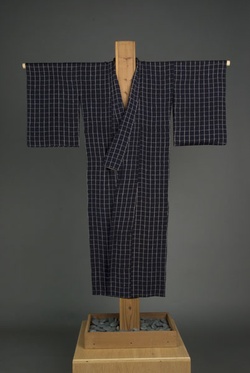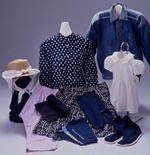When I first began my study, my objective was narrowly defined to describe and to collect samples of work clothing worn by Issei (first-generation Japanese) men and women on the sugarcane and pineapple plantations in Hawaii. I began to interview as many Issei men and women as I could find who had worked in sugarcane or pineapple fields.
As I conducted the interview the scope of my study became broader, my interviews unearthed valuable information about other types of clothing and led to important insights into other aspects of the immigrant experience on the plantations. I soon found that my research was taking me on an exciting journey from the Japanese villages to the Hawaiian plantations—a journey that has not only enabled me to describe the clothing worn by the Issei but also helped me to understand the struggles of the Issei to survive on alien soil and the relationship between their old traditions and the new plantation culture.
My father died in 1928 at age 63, my mother was 39 years old and pregnant with her ninth child. After my father’s death, my mother supported herself and eight children by taking in laundry from plantation bachelors. She used to tell us how she and her sisters learned to weave cotton cloth on their own handloom and how her mother and older sister wove their own silk cloth—which, when completed, was sent to Kyoto to be dyed and decorated with beautiful hand-drawn designs. We children received many of those beautiful hand-woven fabrics.
Thus my research on plantation clothing basically started when I was a child. In the family passport photographs taken in 1921, all my brothers and sisters are wearing kimono and haori (coats) made of intricately woven kasuri (tie-dye cloth) fabric. And my family was not unique in this respect. Kasuri became popular in Japan during the late Edo Period (1603-1867) and reached its height of popularity in the rural villages during the Meiji (1867-1911) and Taisho Periods (1912-1925) when the mass migration from Japan to Hawaii took place. So the handwoven kasuri cloth was worn by the early Issei when they arrived in Hawaii.
At first the Issei men and women began working in the fields in the kimono they had brought with them. Some changes obviously had to be made to meet the needs of the sugarcane and pineapple fields—especially for the protection against the tropical sun, the serrated edges of the sugarcane stalks, the sharp leaves of the pineapple plants, and the stings of centipedes, scorpions, and yellow jackets.
The Issei men quickly adopted the standard plantation attire—ahina (denim) jackets and pants worn by the other ethnic groups. If a garment was affordable, comfortable, sturdy, and served its purpose, the Issei men were not interested in any changes in style. The only changes seen in Issei men’s early work wear were in the variety of work hats and bright red and blue bandannas adopted from Spanish, Filipino, and Portuguese coworkers. Later, in the 1920s, when palaka jackets became popular among the other groups in Hawaii, the Issei men readily adopted them also; they liked the palaka (light-weight denim) cloth because its checked pattern resembled the checked design (goban-ji) used on their cotton kimono and thus evoked memories of Japanese village life.
For wear on formal occasions the Issei men immediately adopted the Western suit. An Issei man usually purchased a dark wool suit early in his settling-down period, which lasted throughout his lifetime. He wore this one dark suit for all occasions such as weddings and funerals and then for his final journey into the next world.
The work clothing the Issei women developed retained many features of their traditional clothing. The arm guards and leggings that the Issei women learned to make out of sturdy ahina cloth were similar to the protective garments used on their farms back home. The wide cummerbund-like sashes that held their work outfit together were a strong reminder of their Japanese folk culture: back in their home villages, they had always worn a wide sash over their kimono. The Issei women liked the comfort and security of the wide black sash tied firmly around their waists. Some of them even said it gave them the strength to endure the hard work on the plantation. And often, when they were hungry, the tightness of the sash helped them to overcome the pangs of hunger. Most importantly, they used kasuri for their work clothing—obtained from kimono they took apart or, later, purchased in the dry goods stores in Hawaii. The kasuri fabric was another link with their past: it was precious to the Issei women in part because it had been favored for work clothing in their home villages.
When innovations seemed useful for them, the Issei women borrowed freely from women of other ethnic groups. The jacket style came from the Chinese women, various types of skirts came from Hawaiian, Spanish, and Portuguese women; and slat sunbonnets came from Spanish, Portuguese, and Puerto Rican women. The Issei women even began to purchase American fabric instead of their beloved kasuri fabric when it became clear to them that it was better buy: the American fabric cost a third less, and it was easier to cut and sew because it was much wider.
The Issei women were relatively slow to discard their traditional kimono for casual wear around the house and for wear on social occasions. But once they found out how comfortable the simple A-line dresses and mu'u mu'u (Hawaiian long loose-fitting dress) were and what freedom they afforded, they enthusiastically adopted those styles of dress. As with everything else they adopted, however, they often made changes to suit their taste—for example, they tended to use fabrics that were similar in color and pattern to traditional Japanese fabrics.
Over the years the Issei women continued to adopt changes in clothing that gave them greater freedom and comfort. By the late 1930s, there were few Issei women workers left on the plantations and some began wearing the same kind of palaka jackets and ahina pants that their male counterparts wore. These outfits were comfortable and took much less time to put on.
As the Issei women changed their outer image, they changed their inner image as well. By the time the Issei women had adopted the palaka jacket like their male counterparts, some of them had risen to the position of luna (foreman) and had outdone their husbands in work performance and earning power. They had become more independent and aggressive.
But neither the Issei men nor the women changed completely. They never abandoned the values and beliefs that had been such an important part of their childhood in Japan; they still respected and valued their cultural heritage. Perhaps that is the real reason why so many of them had never ceased to wear them.
* * * * *
Textured Lives: Japanese Immigrant Clothing from the Plantations of Hawai`i
February 28 - August 22, 2010
The experiences of early Issei in Hawai`i are revealed and illuminated through exquisite examples of kimono adapted for life and labor on Hawai`i’s plantations. The exhibition will interweave these priceless textiles from the National Museum’s Permanent Collection with rare oral histories and moving images, photographs, and expert video commentary by scholar Barbara Kawakami.
For more information about the exhibition, visit: janm.org/exhibits/texturedlives
* This article originally appeared in the Winter 1999 issue of the Japanese American National Museum Member Magazine.
© 1993 Barbara Kawakami







